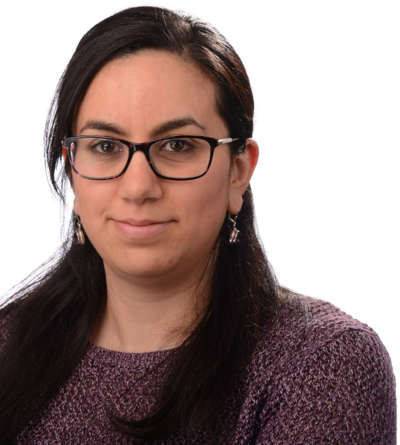ENHANCING PHYSICAL ACTIVITY USING VIRTUAL COMMUNICITIES
Lamia Elloumi is a PhD Student in the research group Biomedical Signals and Systems, her supervisor is Professor Hermanus Hermens from the Faculty of Elecrical Engineering, Mathematics and Computer Science (EEMCS)

Despite the known health and well-being benefits of regular physical activity, reaching the daily recommended level of physical activity is yet challenging for many people. Recent advancements in ICT have the potential to make this easier by providing new means to promote behavioural change aimed at reaching healthy levels of daily physical activity. Pedometers and accelerometers are examples technologies to measure and promote physical activity. Newer technologies are used nowadays to promote physical activity such as video games and internet-based physical activity interventions. In addition to the opportunities offered by new technologies, providing social support (informational, emotional, appraisal and instrumental) is important in order to support people in their daily physical activities. Social support has been positively associated with achieving health goals and engagement in the regular physical activity. In this thesis, we investigated virtual communities as an added feature in internet-based physical activity interventions providing social support to promote and maintain physical activity.
In order to gain knowledge about existing virtual community-based studies to promote physical activity and understand what is done, we carried out a literature review on virtual communities for physical activity support targeting adult population. In this study, thirty-seven publications were included. We analysed these publications from different perspectives: demographic characteristics, physical activity assessment methods and outcomes, evaluation phases, behavioural change theories and provided functionalities. We observed that the use of objective methods for physical activity assessment, the provision of function within different categories (physical activity dashboard, feedback, social interaction, system interaction, and facts and information) and the consideration of all the three phases of evaluation (system creation, system use and system impacts) seem to be related to positive physical activity outcomes. From the results, we observed that no or poor instrumental support is given with respect to the actual execution of the physical activity. Instrumental support is expressed by providing support through functionalities that help in performing certain physical activity tasks in order to achieve physical activity goals.
As a first step towards investigating instrumental support, we designed the TogetherActive system: our proposed virtual community for physical activity support. The virtual community consisted of a web-based system coupled with a physical activity monitoring device. Each of the intended functionalities contributed to the different types of social support: informational support, emotional support, appraisal support and instrumental support. We presented the main functionalities to be implemented, with a focus on instrumental support. We defined functionalities to allow the self-measuring and self-monitoring physical activity level and physical activity goals, in addition to functions to allow group communication and interaction, we also defined personal and group physical activity goals. We implemented the first prototype of TogetherActive with a basic number of functionalities. In order to technically evaluate the first prototype, we performed a usability study with ten participants over one week. We measured the usability satisfaction with the system and for the used physical activity monitoring device. Overall usability satisfaction score was acceptable for the system and low for the physical activity monitoring device. The results of this evaluation gave feedback from users for the next design cycle. We found two major categories for improvements: the user interface and the physical activity monitoring device used. The improvements to be realized are smaller and longer battery life monitoring device, and more clear, intuitive and easy to understand graphics and interface navigation.
Taking into consideration all results from the usability study, we developed a second prototype, the TogetherActive V2 system. We integrated extra functionalities designed and not yet implemented in the TogetherActive system to enhance the social support offered by the platform. We conducted an explorative study to observe the differences between using TogetherActive V2 and a reduced version without the social support functionalities. The explorative study lasted for nine weeks with thirty-five participants. Results suggested that using virtual communities could potentially motivate and support people in their daily physical activity. Another important outcome was that the decrease of physical activity level relative to the baseline week occurred after 6 weeks, whereas in other related studies this already happened after 4 weeks.
In the last study on the investigation of instrumental support, we explored social activation and enhancement of the involvement of peers and their interactions. The idea of social activation is that the ICT system initiates triggers to buddies and helpers to initiate a physical activity, this way a physical activity is turned into a mixed physical/social activity and this way tries to increase motivation. We introduced this ICT system as the Community Coaching system. For this, we started with requirements elicitation where we designed a scenario of use, developed a questionnaire and approached 60 people. Based on the results of the questionnaire, we defined the functionalities, implemented and integrated Community Coaching system within The TogetherActive system. We evaluated the system usability and usefulness. Ideally, this Community Coaching system would be more motivating by turning physical activities into social activities and would enhance the long-term compliance. Although the usability results were neutral, the usefulness results showed that the participants appreciated the idea of the Community Coaching system. The study showed that this approach gives new potential to instrumental support for enhancing physical activity.
This thesis investigated virtual communities for physical activity support. We investigated mainly the instrumental support for physical activity as part of the social support and provided directions on functions that can be implemented in such a system such as the Community Coaching system. The concepts presented in this thesis are easily transferable to other application domains including lifestyles and behaviour change support (e.g., for diet and quitting smoking support) and/or to other user groups (e.g., chronic patients and identified risk groups).





